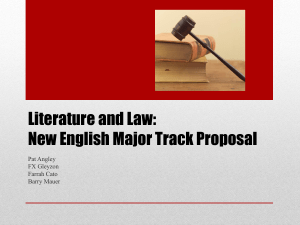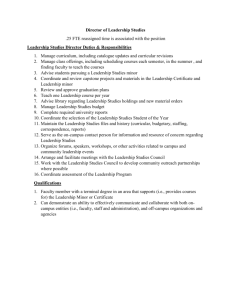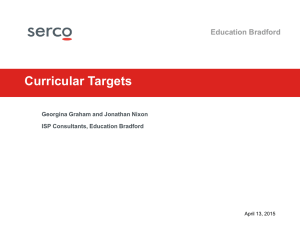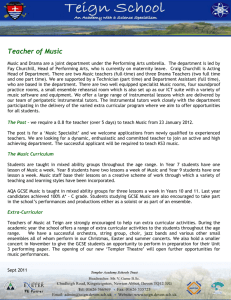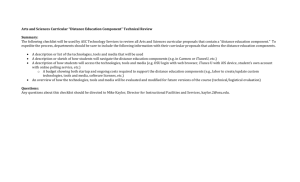A Creative Approach to Teaching Writing
advertisement
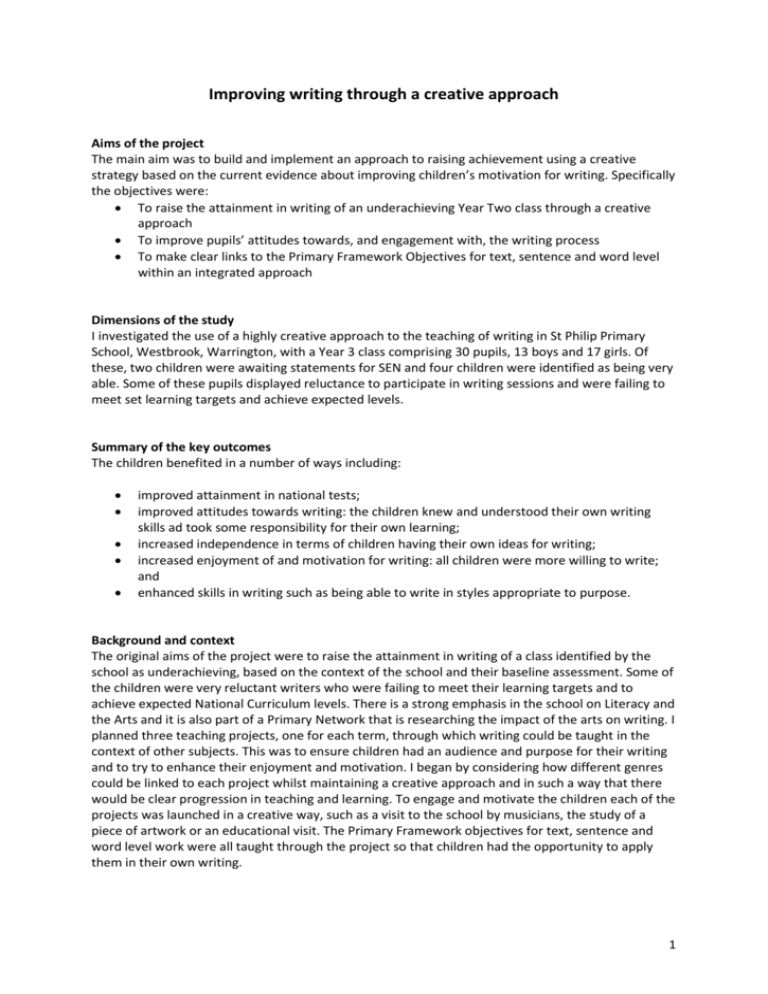
Improving writing through a creative approach Aims of the project The main aim was to build and implement an approach to raising achievement using a creative strategy based on the current evidence about improving children’s motivation for writing. Specifically the objectives were: To raise the attainment in writing of an underachieving Year Two class through a creative approach To improve pupils’ attitudes towards, and engagement with, the writing process To make clear links to the Primary Framework Objectives for text, sentence and word level within an integrated approach Dimensions of the study I investigated the use of a highly creative approach to the teaching of writing in St Philip Primary School, Westbrook, Warrington, with a Year 3 class comprising 30 pupils, 13 boys and 17 girls. Of these, two children were awaiting statements for SEN and four children were identified as being very able. Some of these pupils displayed reluctance to participate in writing sessions and were failing to meet set learning targets and achieve expected levels. Summary of the key outcomes The children benefited in a number of ways including: improved attainment in national tests; improved attitudes towards writing: the children knew and understood their own writing skills ad took some responsibility for their own learning; increased independence in terms of children having their own ideas for writing; increased enjoyment of and motivation for writing: all children were more willing to write; and enhanced skills in writing such as being able to write in styles appropriate to purpose. Background and context The original aims of the project were to raise the attainment in writing of a class identified by the school as underachieving, based on the context of the school and their baseline assessment. Some of the children were very reluctant writers who were failing to meet their learning targets and to achieve expected National Curriculum levels. There is a strong emphasis in the school on Literacy and the Arts and it is also part of a Primary Network that is researching the impact of the arts on writing. I planned three teaching projects, one for each term, through which writing could be taught in the context of other subjects. This was to ensure children had an audience and purpose for their writing and to try to enhance their enjoyment and motivation. I began by considering how different genres could be linked to each project whilst maintaining a creative approach and in such a way that there would be clear progression in teaching and learning. To engage and motivate the children each of the projects was launched in a creative way, such as a visit to the school by musicians, the study of a piece of artwork or an educational visit. The Primary Framework objectives for text, sentence and word level work were all taught through the project so that children had the opportunity to apply them in their own writing. 1 Engaging with research: teaching processes and strategies The projects Each project had a different key humanity thread running through it, namely Religious Education, Geography and History. The projects took place throughout the academic year and I linked all writing to them in order to provide the children with both an audience and purpose. I planned teaching sequences based on the Primary Framework, which provided clear expectations and a systematic approach to assessment, planning and teaching. I carefully chose projects to engage and motivate the children, especially the boys. For example the summer term project was a study of the Aztecs. This led to the children note taking, writing their own information book, writing letters to authors and finally writing their own adventure stories set in Aztec times, which they then turned into play scripts, which were performed in front of their parents. The writing process The children had numerous experiences of writing as a process during the year. All writing had a clear, shared purpose, whether this was for a class book, a letter to an author or to perform to parents and the children learned the need to complete the process and produce a final published piece of writing. They unpicked the genre, gathered ideas, planned, wrote initial drafts, redrafted, edited and published. Children used a variety of planning approaches to capture their ideas and often worked in pairs or small groups at this stage. Children were then encouraged, with my support, to develop their own pieces of writing through the supported transfer of ideas from plans, giving them the opportunity to apply new skills in their writing. Creative teaching approaches Before planning a piece of writing I always provided the children with plenty of opportunity to gather and discuss ideas for their writing. These included the regular use of: visual art; drama; music; role play; small world play; visualisation; and ‘superdays’. All the teaching and learning took place in a rich, stimulating and interactive learning environment. (‘Superdays’ are an initiative launched two years ago by the Warrington Primary Strategy team to improve writing. They involve days designed to give children the opportunity to develop key Literacy skills in a fun and interactive way. All children produce a piece of writing by the end of the day which they can proceed to develop further during the following block of work). This creative approach gave children the chance to develop, share and refine their ideas before applying their learning in their own writing. The rich learning environment supported children’s learning through the display of writing ideas, including writing checklists, word collections and sentence level rules; all compiled during whole class or group sessions. Assessment for Learning (AfL) I used AfL in a number of ways including: identifying children’s needs; 2 exploring pupils’ progress in writing in relation to spelling, handwriting, sentence structure, punctuation, and composition; and agreeing curricular targets with the children. The impact of the creative approach was closely monitored, with all children undertaking independent pieces of writing every half term. These pieces of writing were then analysed and group or individual curricular targets were agreed with the children, to meet both group and individual needs. The children knew what their targets were, understood what they were being asked to do and self assessed their own writing against these targets. Although I put children in groups based on ability, these groupings were flexible and were changed as required, depending on the learning objectives. For example when undertaking a guided writing session to redraft a story, one group of children had the target to begin sentences in different ways. Two children were moved to other groups, either because they had already achieved this target in their writing or because they were assessed as not fully understanding the target. Curricular targets The process of identifying curricular targets was already well established in the school. I used analyses of children’s writing to identify group curricular targets. The children were fully aware of their targets and were involved in the process of reviewing them to identify new areas for development. Although the focus was on the whole class there was also a focus on specific needs, as I set some children individual targets. These sometimes remained secret to maintain self-esteem. Target children were also identified; these generally were children who I did not feel had made the expected level last year or were not on target this year. These children were given more support in class and parents were very involved in the analysis of writing and target setting process. Teaching strategies A range of teaching strategies was used to improve writing, including: modelled writing through demonstration; shared writing with the teacher as scribe; supported composition; and guided writing. Guided writing supported the children in planning and drafting their work at the point of writing or after writing as part of self-assessment. Success criteria included both genre specific targets and curricular targets. Planned intervention through guided writing enabled children to take supported steps towards independent writing. It was targeted towards groups of children according to their current targets or specific needs. Guided writing generally followed on from shared writing over a sequence of lessons. The aim was to provide support to help children improve their writing and to work with increasing independence. Guided writing enabled me to tailor teaching to the needs of the group while facilitating the teaching and learning of individual children within the group. It encouraged children to be active participants in discussion, building confidence and providing immediate feedback. An example of how I taught guided writing during the summer term can be seen on the Primary National Strategies video ‘Improving writing with focus on guided writing’. The outcomes Attainment By the end of the project all children had made progress in writing with most children making significant progress of two parts of a National Curriculum Level or more. Of the 30 children involved: 3 Six children progressed a whole National Curriculum Level or more Fifteen children progressed two parts of a National Curriculum Level Nine children progressed one part of a National Curriculum Level Two boys with behavioural difficulties, who had both previously resisted writing, had progressed two parts of a National Curriculum level each The majority of children (21) were working at or above the expected level by the end of the year. Both children identified as having special needs had achieved level 2B. Attitudes and enjoyment All children were more willing, independent writers who had ideas for writing and who had developed their ability to write in styles appropriate to the reason for writing. They were producing longer, more structured initial drafts and were keen to redraft, edit and publish for the given audience and purpose. The final pieces of work reflected the learning that had taken place and children could identify how they had met their targets within a given piece. Children knew and understood their own writing skills and their curricular targets and so could take some responsibility for their own learning and regularly expressed an enjoyment of writing. As Adam, a pupil with behavioural difficulties, said, “This is easy, I love writing because other people can see how good I am!” Primary Framework objectives Children were applying their learning to their own writing and were more highly motivated and engaged in the writing process. They could identify the skills they already had in terms of text, word and sentence level and had a clear understanding of what they needed to do next to move on. Research methods The data were collected mainly through careful tracking of each child’s progress in writing every halfterm. This included an analysis of what they have achieved in terms of sentence structure, spelling, punctuation, composition and literary effect. These data were then analysed to see which children had made progress when compared with what they had achieved previously and to see whether they were working at an age appropriate National Curricular Level. The analysis also provided information on what the children needed to do next, enabling curricular targets to be set and to inform future planning. Primary Framework objectives These were included in planning and shared with the children. Writing was assessed against these objectives to measure attainment and progress and the children were involved in this process and in setting new curricular targets. Conclusion This creative approach helped the children become more enthusiastic and independent writers. The project gave children an audience and purpose for their writing and a chance to apply new learning in their own work. The opportunities given to children to capture ideas, including talk for writing, supported children in becoming more willing writers. The emphasis on the writing process helped to produce highly focused teaching and learning before, during and after writing. Careful grouping and target setting enabled children to self- and peer-assess, supporting each other’s learning through shared, clear curricular targets. Flexible grouping enabled children’s individual needs to be met, depending on the learning objective. 4 Questions for further consideration How can children with SEN be more successfully catered for? How can writing be made more relevant for all children? Suggestions for further reading ‘Improving writing with a focus on guided writing’ Primary National Strategy, DCSF Ref: 00618-2007BKT-EN ‘Every child matters Change for Children’ DCSF Ref: DCSF-00332-2008 Primary Framework for teaching Literacy and Mathematics Ref: DFES-03876-2006 Developing early Writing Ref: DfES0055/2001, DfES0056/2001 Warrington Grid for Learning: Superdays http://www.school-portal.co.uk/GroupHomepage.asp?GroupID=221956 Author’s contact details Jennifer Hindley St Philip CEAP, Westbrook Centre, Warrington WA5 8UE Telephone: 01925 445391 Fax: 01925 411759 e-mail: StPhilips_Primary@warrington.gov.uk 5
